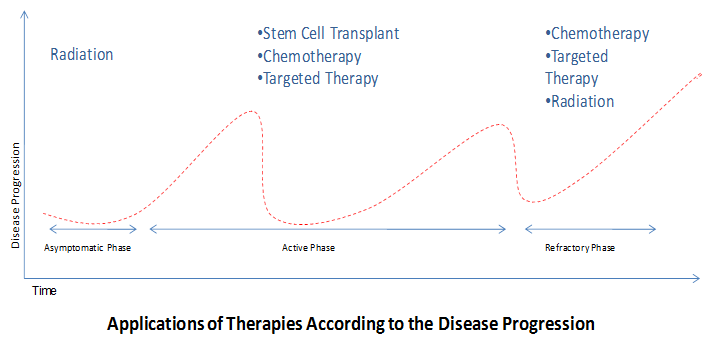Immunotherapy: Promising Treatment Option For Multiple Myeloma
Large number of research and development projects to tap unharnessed opportunities in multiple myeloma therapeutics market indicate the future growth potential. The following research insights focus on details of the market opportunities as well as new therapeutic avenues for patients suffering from the disease for a longer and healthier life.
"Therapeutic market opportunities present through the different stages of the disease"
The therapeutic procedures of myeloma begin with the diagnosis of tumor-related findings obtained through screening procedures such as radiology. The treatment of the tumors starts with radiotherapy, which is a localized procedure and with its effects limited to the tumor region. Radiological procedures are usually preferred as treatment options during the asymptomatic phase of the disease. However, they are also used in the later phases to manage pain caused by bone deterioration. Radiotherapy forms an integral part of any cancer therapy. Recent advancements in radiotherapy such as its ability to transform the localized tumor into an in situ vaccine have widened the scope of the therapy in many applications. Radiotherapy has no effective alternative for its application in multiple myeloma. Thus the usage of this procedure in therapies for multiple myeloma is expected to grow with the surging prevalence of the disease.
"Active myeloma and second line of treatment"
Active myeloma is when the symptoms of the disease actually start appearing, upon the appearance of which physicians decide upon the second and third line of therapy. The first line usually includes stem cell transplant procedures. The procedure involves the storage of bone marrow/stem cells outside the patients’ body, succeeded by aheavy dose of chemotherapy and/or radiation and replenishment of the bone marrow/stem cells. Of the two major types of stem cell transplants, allogeneic stem cell transplants dominated the market over the autologous type. A majority of the patients are determined not suitable candidates for stem cell transplantation owing to various reasons including weakness and age. On the other hand, there are several patients that undergo more than one stem cell transplant procedure to counteract the relapse of the condition.Growing trends of multiple stem cell transplant procedures and advancements such as reduced intensity treatment regimen are expected to increase the revenue generated by these procedures.
"Drugs and chemotherapy in the picture"
After successful stem cell transplants, the major drugs such as immunomodulating agents and proteasome inhibitors are chosen to control the relapse of the symptoms. The dosage of these drugs is decided by oncologists depending upon factors such as age, symptoms, andtherapeutic response. Immunomodulating drugs segment is currently capturing the largest share of the multiple myeloma therapeutics market with it comprising all patented drugs. High price and absence of alternatives are the factors driving the upward trend in the market share of these drugs.

The longevity and quality of patients’ lives are dependent upon the accuracy of the drug therapies after first or second line of treatment. These drugs are usually prescribed in combination with chemotherapy and corticosteroids.
With recent developments in immunotherapy and faster drug approval process in effect, recent introduction of newer therapies including monoclonal antibodies and Histone Deacetylase (HDAC) inhibitors is expected to positively influence the market. These therapies have advantages over traditionally used drugs including high cell specificity in targeting cancer cells without damaging surrounding tissues and greater effectiveness. In other words, these drugs are safer than the traditional ones.The next lines of therapy in the refractory period of the disease are fully dependent upon these drugs and chemotherapy.
"High adoption of newer therapies in the U.S. and growing demand in Europe"
Darzalex, a brand of monoclonal antibody, and Daratumumab, which have been approved in the later part of 2015, is estimated to cross the revenue of USD 400 million in 2016 in the U.S. The determinants such as high disposable income and high adoption of the newer therapies have aidedthe development of these drugs in the nation. Europe is closely followed by the U.S. in capturing a sizable share.
"Patients still awaiting a permanent cure"
Despite all the developments in drugs and procedures, multiple myeloma patients get an extension of 6 years of life after the diagnosis of the disease, which is spent mostly in undergoing treatment. Patients are still awaiting an effective and permanent cure for the disease. The preventive measures such as vaccines and early detection technologies including personalized diagnostic methods are expected to provide better therapeutic outcomes for multiple myeloma patients in the near future.
 In-depth report on global multiple myeloma therapeutics market by Grand View Research:
In-depth report on global multiple myeloma therapeutics market by Grand View Research:
https://www.grandviewresearch.com/industry-analysis/multiple-myeloma-therapeutics-market